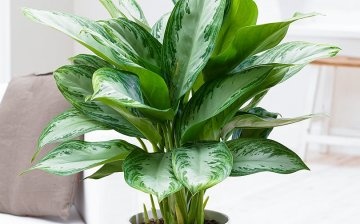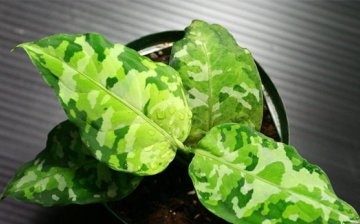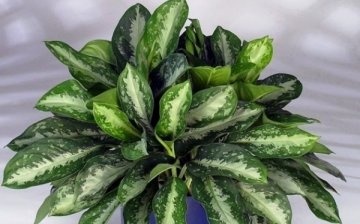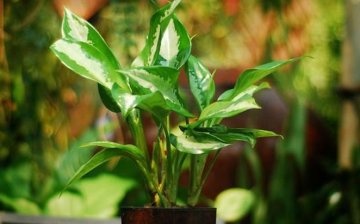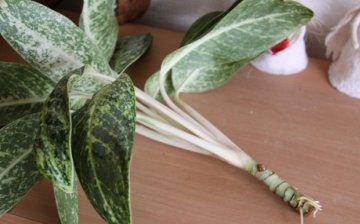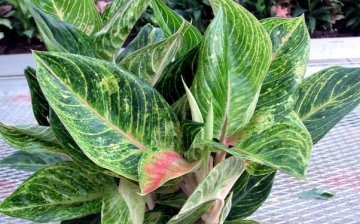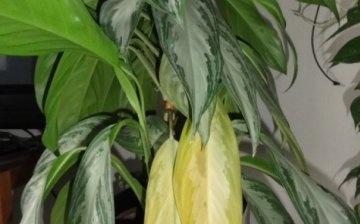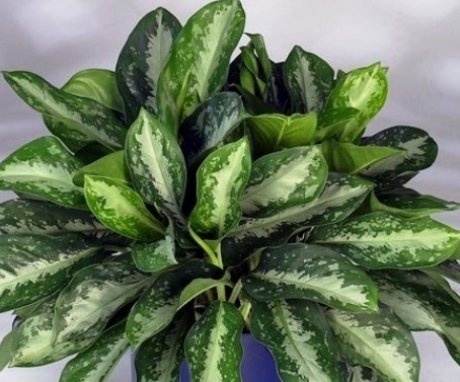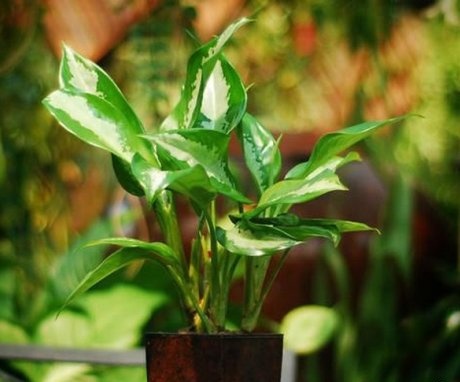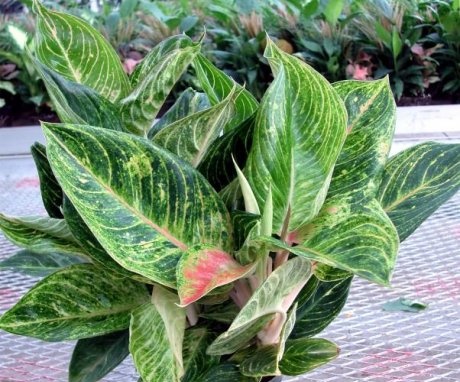Aglaonema - planting and caring for a tropical plant
An unusual ornamental plant, aglaonema, not only decorates the darkest corners of the room, but also purifies the air. Its variegated leaves attract the attention of guests, and the rare bloom delights the grower - after all, this phenomenon is not typical for the development of aglaonema at home.
An unpretentious, beautiful and wholesome culture is increasingly appearing in rooms, living rooms and conservatories. It is not difficult to grow it, but it is necessary to observe some features during planting, care and reproduction.
Content:
- Description of aglaonema
- Types and popular varieties
- Growing conditions
- Reproduction methods
- Aglaonema care
- Diseases and pests
Description of aglaonema
Aglaonema grows wild in the tropical forests of the Malay Archipelago, East India, Southeast Asia and New Guinea. Loves the lower tiers of rain forests, is located along river banks, swamps, less often in the foothills. It is an evergreen bush or semi-shrub, depending on the species and variety. The stem is erect, short, fleshy. Leaves, elliptical, are attached to the main stem with petioles. Leathery, large, whole at the edges, dense.
Often a pattern is formed on the leaves - spots or stripes of a silvery, red, light green or yellowish hue.
The vein is sagged in the middle and convex on the reverse side of the leaf. Aglaonema inflorescences are dense cobs in a light green veil. The fruits ripen in 6-8 months, depending on the species - berries with one seed inside, white or scarlet.
Aglaonema develops slowly and adds only four to five leaves per year. The juice and fruits are poisonous. According to the legends of the flower growers who grow this plant, aglaonema brings good luck to the house. It is hardly possible to verify this statement, but clean air in the room is definitely guaranteed. The flower is used for decoration of premises and landscaping of winter gardens, greenhouses. Aglaonema is often grouped with other lush-flowering crops. There are from 20 to 50 types of culture. But not all are cultivated at home.
Types and popular varieties
Consider the commonly grown aglaonema species and some of their popular varieties. More often the culture is a hybrid, while varietal species are rarely used. They are bred for the purpose of further selection, they are quite capricious and difficult to find on sale.
So, the following types and varieties are distinguished:
- The species is "changeable" - the bush grows up to 1.5 meters, the leaves are large, reaching 30 cm in length and 10 cm in width. If the plant suddenly blooms at home, then the grower will be surprised at the beauty of large ears in a blanket of the same size. Popular varieties: "Maculatum" (white strokes on the leaf), "Warburgii" (white stripes along the veins), "Elegance" (the pattern is formed by light green stripes, strokes).
- The type "oblong-leaved" - is distinguished by an amazing pattern on a silvery sheet against a green background. The leaves are large, reaching 30 cm in length.
- Type "painted" - the leaves are decorated with a silvery pattern. But not only the decorative greenery attracts attention, but also the bright red fruits. It looks very impressive. The plant reaches 60 cm in height.
- The "shiny" species is a small shrub reaching a height of 50 cm. The leaves are shiny, oval, dark green in color. The fruits are white.
- "Ribbed" is a low herbaceous plant, the leaves are decorated with white strokes against a green background. The stem is highly branched.
- "Modest" - fruits of this type are interesting, they resemble a berry dogwood... Red and juicy. The leaves are green without a characteristic, bright pattern. It reaches a height of 50 cm.
All species are cultivated and grown by flower growers. Such varieties and hybrids as Silver Bay, Siam Aurora, Pride of Sumatra are popular with plant breeders. The latter is distinguished by an amazing color combination - pink veins and the same shade of the lower part of the leaf. It looks impressive and unusual.
Choose species, varieties and hybrids according to personal taste and indoor decor design. Whatever you choose, aglaonema will take root and delight with its beauty, subject to the conditions of cultivation and proper care.
Growing conditions
Aglaonema is an unpretentious plant, but given the homeland of its origin - the tropics, you should choose the right place for it and observe the temperature regime, humidity level and degree of illumination. Neglecting the rules of maintenance, it will not work to grow it.
Prerequisites for the beautiful growth of aglaonema:
- Lighting and temperature control. The culture prefers partial shade - for species with a uniform, green color and diffused sunlight - for hybrids with a pattern on the leaf. You cannot put the flowerpot on a windowsill where direct sunlight falls. It is better to choose a shaded place in the room, away from the window. The optimal direction of the windows is West or East. Aglaonema develops well in the shade. The temperature regime in summer is from 22 ° to 25 °, in winter - from 16 ° to 18 °. If the indicators are not maintained, the plant begins to hurt and soon dies. There should be no drafts in the room. Choose a small, warm room with diffused sunlight and no cold air currents. Any temperature drops have a detrimental effect on the health of the aglaonema. Therefore, it is so important to maintain temperature readings and observe lighting conditions.
- The soil. The substrate is light, fertile and slightly acidic - the best option for a flower. The main condition is water and air permeability. The soil mixture is prepared from equal parts of peat, sand, turf, leafy earth, humus and, if desired, add perlite. Many experienced growers add charcoal to seven, which will not be superfluous for disinfecting the soil. The soil for mature plants does not differ in composition, but you can increase the dose of leafy soil and peat. However, this condition is not so important. The substrate is changed every 2-3 years for young plants and once every 4-5 years for adults.
- Air humidity. High air humidity is another integral factor in aglaonema cultivation. In summer, it is often sprayed, bathed, moistened with warm, settled water. It is very important not to water the plant with cold water mixed with chlorine. It will die. An important factor in growing is the absence of tobacco smoke, the plant does not tolerate it. Therefore, it is impossible to install the pot in smoking rooms, as is done in many offices. Maintaining the moisture level is very important. The fact is that when the soil is waterlogged or dries up, the culture instantly begins to react - with drying leaves, yellow or gray spots, deformation of greenery, slow growth.
Growing conditions are not so difficult, they are necessary for many indoor plants. Providing the aglaonema with the necessary temperature indicators and the degree of humidity, it will certainly delight with its unique charm.
Reproduction methods
The most common breeding method is vegetative. Dividing the bush or stem grafting... The culture is propagated by seeds very rarely due to the rare flowering at home.Often, the seed does not germinate, does not retain germination for a long time. Seeds are sown directly from the bush.
Cutting is best done in spring or early summer.
Cuttings cut off at the very base and divide, if possible, into several parts about 8-10 cm long. Each part should have 1-2 leaves, dry the cuttings a little until flabbiness - one day, no more. Then dip them either into a moist peat and sand substrate, or into water until roots appear.
Dividing a bush is a renewal of an old plant and a way of propagation at the same time. This procedure is carried out either in the spring or in the summer. When dividing root system work with gloves, as aglaonema is a poisonous plant. Vegetative propagation is considered simple and effective. Seeds are rarely used.
Aglaonema care
Plant care is not as difficult as many people think. This is timely watering, feeding and rare transfer plants. Aglaonema is not picky, the only thing you shouldn't forget is timely watering. In summer, the soil is moistened quite often, the upper layer of the substrate must not be overdried. It is also not recommended to breed dampness, otherwise root rot will appear. However, if the temperature regime is observed, it is very difficult to overmoisten the substrate.
Aglaonema is a real "water-bread" and is very fond of sprinkling procedures, wet wiping of leaves and watering with warm, settled water.
In winter, the soil is moistened only once a week. To make fertilizers culture is supportive and responsive to application organics and mineral complexes with accelerated growth and lush greenery. The plant is fed twice a month during the period of active growth - in summer, in winter it is stopped altogether.
The care also includes transfer... It is carried out in the spring, when the flower outgrows the flowerpot. It is very simple to define it. The lateral leaves begin to dry out or turn yellow, and in the middle, new ones develop. Water does not absorb well. These are the first signs that the plant has overgrown. A young plant is transplanted into a fresh substrate and a larger flowerpot once every 2-3 years. Adult - once every 4-5 years. To form a lush bush, pinch the upper stem. So the plant begins to branch out and takes on a dense, dense shape. If all the rules of care are followed and optimal growing conditions are maintained, the culture will not get sick, and pests are unlikely to appear. But sometimes there are troubles, which will be discussed below.
Diseases and pests
The only disease that can affect aglaonema is root rot. But even this ailment appears as a result of improper care and maintenance. The rest of the problems appear when waterlogging, due to temperature fluctuations or drafts. Allocate:
- Gray spots on greenery. The reason is low temperature, the solution is a change in temperature.
- Unpleasant oily coating, black spots, dry edges. The reason is low air temperature, the solution is to change the temperature regime or move the flowerpot to another place, warmer, without temperature changes.
- The leaves turn pale. The reason is excessive lighting, the solution is to move the flower into the shade or artificial shading.
- Dry leaf edges or yellow spots. The reason is direct sunlight, dry air, the solution is shading and increasing the level of humidity in the room.
- Yellowness of the leaf. The reason is tobacco smoke, draft, dry air or soil. You may have to move the plant to a non-smoking room, the humidity level is high, or you just need to water the crop in a timely manner and care for the aglaonema.
For the most part, flower growers are faced with these manifestations. Pests also appear due to non-compliance with the conditions of maintenance and care. Annoy aphids, thrips, mealy worm, scale insects or spider mites.Methods of struggle come down to removing parasites by hand or using water in the shower.
More information can be found in the video:
If these are scale insects, use a cotton pad dipped in alcohol or vodka. To process drugs a flower with scale insects on leaves and stems is not allowed.
There will be no positive result, since the parasite is protected by a shell, no chemistry will help. After removing pests from the plant, you can start treating it with insecticides. It is carried out 1-2 times with an interval of a week.
Given the natural resistance of the plant to diseases and pests, problems can arise only due to improper care and maintenance.
It is not difficult to grow aglaonema at home, if a suitable place has been chosen, the temperature regime is observed and care rules... Very often, flower growers even forget that this crop needs certain growing conditions. This is because a good place was chosen without drafts, warm and humid. So the plant develops without problems and pleases the owners not only with its decorative appearance, but also with clean air!



